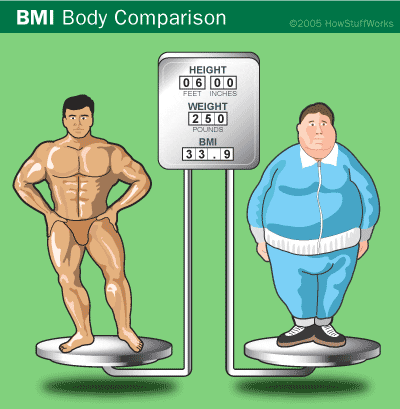
Simply put, the world is getting less and less healthy. According to the National Center for Health Statistics, between the years 1999 to 2002, 64 percent of Americans over the age of 20 were overweight or obese. Such statistics represent a key element in the ongoing debate over America’s supposed obesity epidemic. These statistics were compiled using the notion of body mass index, a somewhat controversial and, at times, unreliable way of determining healthy body weights for Americans.
Before getting to the heart of the BMI debate, one must first understand just what BMI is. Essentially, BMI is a number based on height and weight that is used to analyze the effects of weight on people of varying heights. BMI has predetermined levels that indicate a person’s health with respect to their weight. For instance, the Centers for Disease Control and Prevention considers a BMI below 18.5 underweight while one between 18.5 and 24.9 is considered normal. Anything above 25.0 and less than 29.9 is considered overweight, while a number 30.0 and above is considered obese. Calculating your own BMI can be done in a matter of seconds by dividing your weight in kilograms by your height in meters, squared.
While these standards might appear to offer a clear index of exactly what is and isn’t healthy, overweight or obese, that is not necessarily the case. BMI is only an estimate of obesity. A common misconception with respect to BMI is that it indicates a person’s percentage of body fat. This is not true, nor should BMI be considered the determining factor as to whether or not a person is overweight or obese. Statistics such as those released by the NCHS are somewhat misleading, as BMI is not a universal tool for every individual. For example, many bodybuilders have BMIs above 25.0, yet no one would classify them as overweight or unhealthy. In other words, what might be a drastically unhealthy BMI for one person might be perfectly fine for another person with the same height and weight.
When determining a person’s BMI, body fat distribution is never taken into consideration. Numerous studies, for instance, have linked abdominal adiposity (measured by the waist-hip ratio or waist circumference) with cardiovascular disease. Therefore, someone with an unhealthy amount of fat in his abdominal region is at a greater risk for heart disease, regardless of his BMI. By failing to take fat distribution into account, the BMI could potentially be very misleading, implying that a person is healthy and not at risk when that might not be the case at all.
Similarly, BMI does not take into account the weight of muscle versus the weight of fat. A bodybuilder who is 6 feet 3 inches tall and weighs 220 pounds will have the same BMI as someone who doesn’t exercise but also is 6 feet 3 inches tall and weighs 220 pounds. Clearly, the former will be healthier, while the latter is likely carrying around an unhealthy amount of fat. However, the BMI formula will suggest these men are of equal health.
That said, why is BMI even used at all? As a guideline, BMI is quite valuable, offering a formula for adults (BMI offers age and gender specific guidelines for children separate from those for adults) to determine whether their weight is considered healthy and if their weight is increasing their likelihood for cardiovascular disease or diabetes. When looked at as more of a suggested value and an estimate rather than a deciding factor on health or obesity, BMI offers a great guideline and formula that can be easily applied at home. Still, the best and most accurate means of determining whether or not your weight is healthy is to visit your physician, who has access to a variety of tests that will offer you more than just an estimate.

Be the first to comment